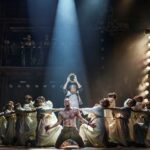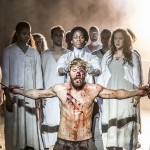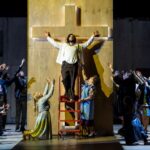In 1970, no-one would risk staging some new-fangled, rock-inspired musical drama all about Jesus Christ Superstar, based on Gospel stories of disastrous run-ins with high priests, the ruling Roman Empire and nasty King Herod, and his fatal betrayal by disciple Judas. So young, wide-eyed hopefuls, Tim Rice and Andrew Lloyd Webber, shared their ground-breaking, sung-through rock opera, instead, on vinyl, as a concept album. Thereafter, of course, the whole world went wild for it, and since 1971 it’s been staged over and again worldwide in oh, so many ways!
This latest interpretation sets the music itself at the heart of the production. As at a concert gig, the characters sing almost exclusively at mic-stands or into hand-held mics while a highly choreographed ensemble fills the stage with incessant, gig-style wiggle and sway and crowd-scene frenzies. But can this singing at/to a microphone approach really cut the mustard? If a show’s not to be a mere Songfest, focused on the singers themselves, it needs to fully involve and engage through expressive singing and acting so their characters, story, emotions, relationships and interactions sparkle with life. The words and music in each song have a vivid story to tell and must define each character, but this isn’t easy for the likes of Mary, Jesus, Judas and the rest when singers at mics often aren’t even looking at the characters they address, let alone building convincing relationships or chemistry. Can sympathetic, emotionally believable characters properly emerge, or over-the-top, larger than life ones? Glimmers shine through, but these difficulties are compounded by an unwieldy set that puts distance between characters and likewise works predominantly against intimate, meaningful interactions. Moreover, a repetitive, never-ending choreography of rock, sway and spiky display, restricted largely to one side by the set, distracts, detracts and annoys more often than it enhances. Relentless and repetitious, it too often takes focus from where it should. More varied routines have more nuanced impact, as when dancers fill the space with brightly lit crosses or surround Jesus with metallic palm leaves.

The dark, heavy set fills the stage on two levels with girders, stairs and platforms of metal and wood, shining portholes of round, orange and white lights suggesting the internal guts of an ancient galleon. While a huge cross looms in the murk at the back with branches atop, it’s a boxy, cruciform catwalk at elevated angle, sometimes internally lit, that dominates the stage and creates a one-sided bias. But with costumes and set so dark and subdued, there’s plenty of scope for dazzling impacts of piercing, bright lights, back-lights, streaking searchlights and copious mists, and of rare appearances of brighter clothing amongst the otherwise colourless, loose, casual range of hoodies, floppy pants, tops and trainers. King Herod’s truly voluminous outfit of camp, camp gold is in most startling contrast, and even the disciples stand out, suddenly draped in red and blue, frozen and immobile in their Da Vinci style Last Supper tableau, leaving Jesus (variously clad in white, baggy jacket akin to a dairyman’s coat or in vest, hoodie, baseball-cap or bare-topped) to sing in peace.
Playing on the two levels, largely shrouded in darkness and mists, the onstage band thrills throughout with fabulous music-making from guitars, bass, sax, flute, trumpet and horn; some guitar-toting cast members also make fine instrumental contributions. Though the creation of convincing personas and emotional interconnectedness is hampered by the mic-singing and frequent onstage separation, all the singers, harmonious ensemble included, have fine moments, vocals ranging from quiet and tender to scream, screech, falsetto realms. Luke Street sings fabulously and with conviction as Simon, while the reverberating bass of Jad Habchi’s long-haired high Priest Caiaphas brings its own special pleasure. As stark, leather-clad governor, Pontius Pilate, Ryan O’Donnell sings wonderfully, his expressive acting properly engaging in bringing situation and emotion alive as he interacts with Jesus (Ian McIntosh) and projects further hostility by directly eye-balling the audience.

The scourge scene is an outstanding spectacle: music throbs as Pilate counts out all the sounds of 39 lashes upon Jesus’ bloodied body, each lash delivered not by a whip but in a symbolic stream of sparkling glitter. Silver and gold images work effectively at other times, too, most notably as treacherous Judas (Shem Omari James) does a Lady Macbeth with his hands steeped indelibly in silver paint, while later, a dangling microphone swings at the end of a long, long cable, an effective image of his hanging.
With its iconic score, visual spectacle, some tense, moving moments and plenty of big singing this show still fills its audience with jubilation.
Eileen Caiger Gray




